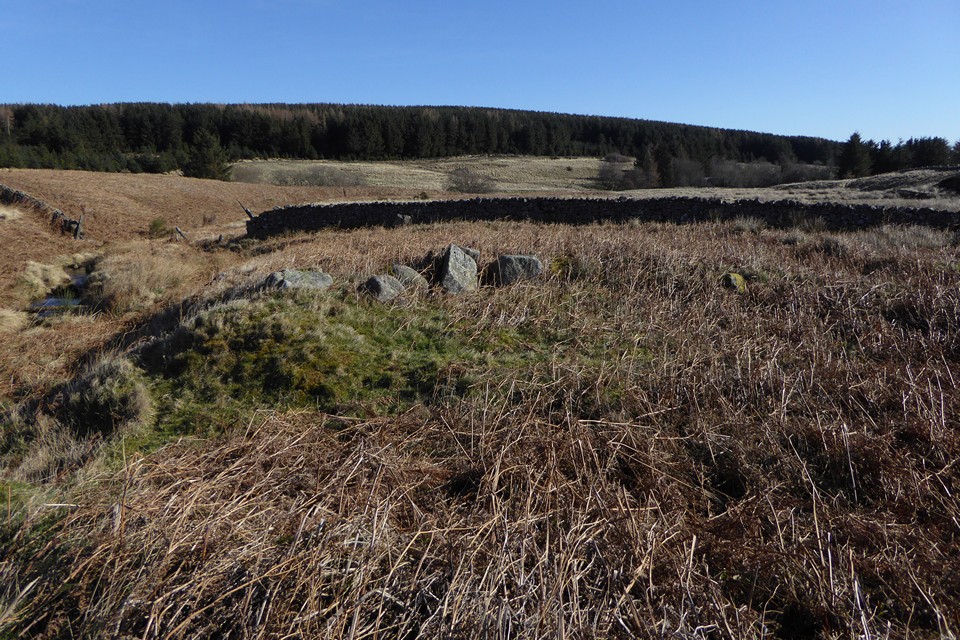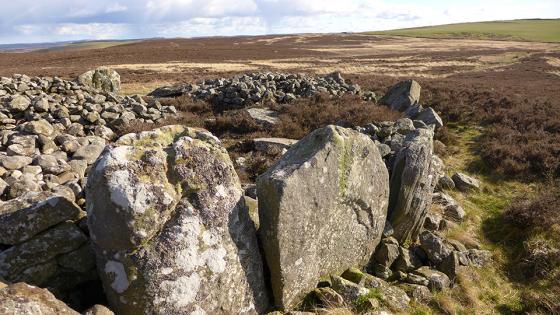
The circle with Hedgehope Hill rising behind.

The circle with Hedgehope Hill rising behind.

The enclosure across the burn, looking towards Hedgehope Hill and the Cheviot.

The enclosure across the burn from the circle.

Two of the stones in the “row” to the northeast of the circle.


Fallen stone in the northeastern arc.

Not all the stones are large, some are smaller than these and half-buried in the grass and peat.

Looking north-ish across the circle.

The three largest stones of the circle.

Looking east-ish along Threestone Burn.

General view of this excellent circle.

Tate’s plan of the circle.



Part of the remains of the threestone burn circle
Plans are afoot to fell the plantation around the circle over a period of 3 years. A decision is expected early in 2009. More details can be found on the Journal’s website, here.
Came across this stone whilst on walk over the Cheviot and Hedgehope Hill, it’s actually a couple of miles North of the circle at 98199 22452. Looks like a contender to me and is not part of a dyke etc.
There are two tracks to threestone burn, the one we chose had us park at South Middleton and walk the three miles to the circle over bridleways and pathways.
To the left and right on the route there is a cairn and a remains of a fort. Looking backward on the way, you can see across to Old Bewick.
To reach the Circle you must walk through the garden of Threestone Burn House, so tread politely (no dogs seen or heard) cross the stream and follow the path towards the woods, the circle is on the left as you reach the woodland.
Overgrown in its surroundings, Burle states one of the stones is 5ft 6, but I dispute that. The northern end of the circle is closest to being intact, other stones are fallen or removed.
The modern landscape is blocked by plantations, but its proximity to Cheviot & Harthope suggest worship of the mother landscape.
Access is denied until June 2002 due to woodland operations
Stoney folklore:
On the top of “Hedgehope,” the round-headed hill that is neighbour to Cheviot, there is a hollow in an incised stone, known as the “Bluidy Trough,” on account of the colour given to the water by the orange-red moss or lichen covering the stone. It is lucky to make a wish here, and drop in a crooked pin – a great number can be seen clearly, lying in the bottom of the hollow, in the water.
Contributed by Mr. T--., Belford, Northumberland, estate agent.
From ‘County Folk-lore’ volume 4, Northumberland, by M C Balfour and N W Thomas (1904).
How many stones are there at threestone burn? There aren’t three. There are supposed to be 16 of these pink granite stones, according to English Heritage’s records. But ... the circle
consisted once, tradition rumoured, of 12 stones, but only 11 of them were visible, and it was foretold that whenever the 12th was found, a fortune in money would reward the lucky discoverer. The present worthy tenant, at the head of a company of hay-makers, whose work in the adjacent haining had been interrupted by a shower, instituted a search after the missing pillar, and lo! instead of twelve there were thirteen stones. Thirteen is always an unlucky number, so his painstaking was unremunerated. Perhaps he was not aware that Druid money is only bestowed by reversion in the world to come.
From the Folklore Society’s publishing of the Denham Tracts, v2.
To add to Moey’s observations.
Here the ring is situated at the confluence of two streams, is overlooked by the summit some 0.5kms to the north-west of Tathey Crags, and the greater eminence of Hedgehope Hill to the west-south-west, these two hills framing The Cheviot which lies due west of the circle. Threestoneburn again sees the occurrence of four elements in direct conjunction.
The long cairn on Dod Hill, lying roughly 1km to the east of the Threestoneburn circle, is of some interest in itself and may have added to the importance of the general location. The cairn is in a prominent location as seen from the main route to the circle, and has been constructed to lie across the contours with it’s broad terminal aligned on the summit of Dod Hill. It is visible on the horizon for part of the journey to the stone circle. This suggests that it may have been deliberately focused upon the hill top, possibly producing a link between the symbolism of the topography with the remains of the ancestors.
Peter Topping
Different Realities: the Neolithic in the Northumberland Cheviots.
Oxbow Monograph 86
Oxbow Books 1997













































































































































